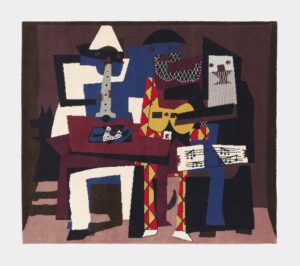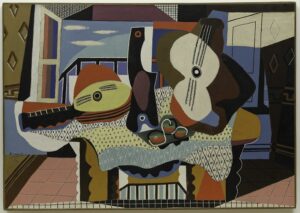Roll into Cubism: “Portrait Game”

Summary
This open toolkits can help learners learn about synthetic cubism easily. Through dice games, randomness and creativity, reality and imagination are combined to create a Picasso style collage portrait of their own.

Three Musicians © 1921 by Pablo Picasso is licensed under CC BY-NC-ND 4.0 To view a copy of this license, visit https://creativecommons.org/licenses/by-nc-nd/4.0/

Mandolin and Guitar © 1924 by Pablo Picasso is licensed under CC BY-NC-ND 4.0. To view a copy of this license, visit https://creativecommons.org/licenses/by-nc-nd/4.0/
Please take a close look at these two images
What details or features do you observe?
Have any additional elements been incorporated into them?
Let’s continue exploring further!
Part I: What is synthetic Cubism? (1 minute)
In the artistic revolution of the 20th century, synthetic cubism became an important turning point in the development of cubism. In 1912, Pablo Picasso and Braque broke through the monotoned analytic cubism. They were no longer limited to the geometric decomposition of objects, but the bold use of color, geometric restructuring, and the integration of picture levels. Collage art is created by incorporating elements from real life such as newspapers, wood grain, and cloth into paintings. In this artistic exploration, the elements of daily life and artistic creation are integrated, and the traditional boundary between reality and imagination is broken. This not only transcends conventional forms of expression but also sows the seeds of innovation for modern art schools such as futurism and Dada.
Guillaume Apollinaire said, “Synthetic Cubism builds on the rubble of traditional forms, creating a new reality that transcends imitation.”
What if you could create your own synthetic cubist artwork by combining random elements from daily life?
how multiple perspectives can be combined in a single work of art?
With your questions in mind, let’s start part II!
Part II: Portrait Game (15 minutes)
In synthetic Cubism, randomness and freedom are one of the keys to breaking the rules of traditional art. Let’s experience this randomness with dice and see what Cubist works of art we can create!
dice:https://www.online-stopwatch.com/online-dice/
Please open this file: Dice game
Online participation:https://miro.com/app/board/uXjVL-ZHLC8=/?share_link_id=219513226742
Georges Braque said, “Art is a wound turned into light.”
Part III: Share and Thinking (4 minutes)
Let’s think about it!
If you’d like, you can take a picture of the painting and upload it here, and share what emotion the painting is trying to express.
How can the principles of synthetic cubism—breaking boundaries, freedom elements—apply to other areas of creativity or daily life?
In real life, do you see a connection between synthetic Cubism and modern digital art?
(Modern digital art is an art form that uses digital technology and tools (such as computers, tablets, and software) to create and express, including painting, animation, virtual reality, and other media.)
What was the most fun or surprising part of the activity for you?
Please answer the above question and reply to this post
Online material:
Printed portrait image: material
Collage material website:https://uk.pinterest.com
Three Musicians © 1921 by Pablo Picasso is licensed under CC BY-NC-ND 4.0. To view a copy of this license, visit https://creativecommons.org/licenses/by-nc-nd/4.0/
Mandolin and Guitar © 1924 by Pablo Picasso is licensed under CC BY-NC-ND 4.0. To view a copy of this license, visit https://creativecommons.org/licenses/by-nc-nd/4.0/
Roll into Cubism: “Portrait Game” Online participation © 2024 by Yuewen Sun is licensed under Creative Commons Attribution-NonCommercial-NoDerivatives 4.0 International
Printed portrait image © 2024 by Yuewen Sun is licensed under Creative Commons Attribution-NonCommercial-NoDerivatives 4.0 International
Roll into Cubism: “Portrait Game” © 2024 by Yuewen Sun is licensed underCreative Commons Attribution-NonCommercial-NoDerivatives 4.0 International
Cover image © 2024 by Qiaoqiaois licensed under CC BY-NC-ND 4.0. To view a copy of this license, visit https://creativecommons.org/licenses/by-nc-nd/4.0/


